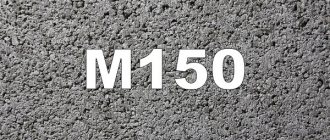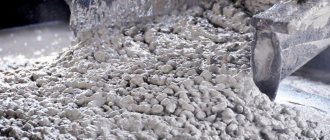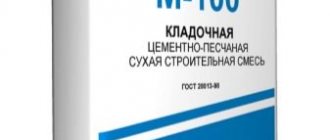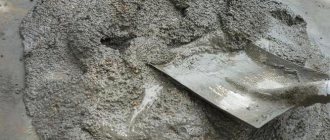Factory produced cement. Photo Petrovich
Manufacturers produce a wide range of types of cement for general and special purposes, which can also be classified into individual grades . The most popular brand in civil engineering is M400. The M400 binder has sufficient technical and operational characteristics to ensure the necessary strength, reliability and durability of concrete structures of various types and purposes.
What does the marking mean?
The designation “M400” refers to the old-style marking, according to which the following information is indicated:
- The type depends on the type of main raw material used for production; a distinction is made between Portland cement (PC) and slag Portland cement (SPC).
- Brand , the number in which demonstrates that the compressive strength of the material is at least 400 kg/sq.cm.
- The presence or absence of modifier additives that change individual characteristics of the solution is indicated by the letter “D” with a number. M400 cement is produced in pure form, then the marking is M400 D0, and with special additives, the amount of which varies from 5 to 20% - from M400 D5 to M400 D20. Additives present in the composition give the concrete additional characteristics: increased resistance to sea water, an increase in the number of frost resistance cycles, slow or rapid hardening, etc. Manufacturers can introduce technological additives into the composition: to facilitate the process of grinding clinker and gypsum, improve transportation, etc.
- The letter “B” is a fast-hardening material, “N” is a normal-hardening material.
- "SS" - sulfate-resistant cement.
- “PL” and “GF” are plasticized and hydrophobic cement.
Portland cement. Vimos Photos
In the new marking, there is no concept of brand, but there is a strength class. In accordance with Soviet standards, strength was measured in kg per sq. cm. According to new standards, the indicator is indicated in MPa (megapascals). The M400 brand corresponds to 32.5. The label contains the following information:
“CEM/CEM” and Latin numbers demonstrate the material composition of the product:
- CEM I - PC without additives;
- CEM II - PC with mineral additives with a share of 6 to 35%. In accordance with the proportion of additives, two classes are distinguished: A - 6-20% and B - 21-35%. Type of additives: “P” - pozzolan and “Sh” - slag.
- Subclass: “N” - normal-hardening or “B” - fast-hardening.
Cooking technology
The process of preparing DSP M400 is simple, but has its own nuances. The main requirement is to mix the components as thoroughly as possible.
Important! The components are mixed in a dry state, preferably in a concrete mixer!
Next, water is added to the dry mixture in small portions until the fluidity of the solution reaches the desired consistency. The approximate amount of water is indicated above. After preparation, the mixture is allowed to stand for 15-20 minutes, and the solution is ready for use.
Composition and production
The starting materials for the production of cement are materials of natural origin : clay and gypsum. , crushed and mixed in the required proportions, are fired , resulting in clinker, which is an intermediate product of the production process. Clinker is combined with additives that affect the final characteristics. can be added to the composition to improve certain properties : plasticity, resistance to negative temperatures and aggressive environments. Production can be carried out according to wet, dry and combined methods. The technology differs slightly, but the list and sequence of steps are generally the same. The composition of cement differs depending on the type.
Manufacturers
Cement production enterprises are located in almost every region of Russia. Proximity to the manufacturer will significantly reduce the costs of transporting large quantities of cement. In addition, at regional factories, various substances are added to cement that improve the physical and mechanical properties of structures, taking into account the specific weather and water conditions of the area.
Here are some examples of businesses located in different regions:
- Association "Yakutcement" - Republic of Sakha.
- Podolsk cement plant - Podolsk, Moscow region.
- Teploozersky cement plant – Jewish Autonomous Region.
- Novotroitsk cement plant - Orenburg region, Novotroitsk.
- Verkhnebakansky cement plant - Krasnodar region, Novorossiysk.
There are dozens of similar enterprises. There are also large manufacturers on the market, known throughout Russia and even in Europe. For example:
Technical characteristics of the brand, advantages and disadvantages
It is possible to list the characteristics common to all types of M400 cement:
- Compound . M400 cement is a complex composition of components of natural origin, the share of which reaches 98%. The composition is dominated by oxides of calcium and magnesium, oxides of aluminum, iron and silicon.
- The compressive strength after 28 days is at least 30 MPa.
- The bulk density of the loosened binder varies from 1000 to 1200 sq.m./m3; in compacted - 1500-1700 kg/cub.m.; in humidified conditions - up to 3000 kg/cub.m. The indicator depends on the fineness of grinding and the presence of impurities.
- Speed of setting and hardening. Indicators are determined in normal climatic conditions at temperatures from 18 to 22 degrees Celsius. The setting process begins no earlier than 2 hours after mixing. A set of brand strength (up to 98%) occurs after 28 days.
- Frost resistance is at least 100 freezing and thawing cycles - F100. The exact parameters are determined by the composition of the cement. The greatest frost resistance is inherent in sulfate-resistant mixtures.
- The operating temperature range is from -60 to +300 degrees Celsius.
- Water resistance is high; to ensure complete impermeability to moisture, sealing additives and waterproofing agents are introduced into the composition.
- The shelf life in sealed packaging does not exceed 12 months.
- Durability . Water resistance, frost resistance, and amorphousness to most solvents provide concrete structures based on M400 cement with a long service life.
Cement M400 in big bag. Photo Asia Cement
A significant part of the technical characteristics can be considered as advantages, which also include:
- ease of use , low requirements for the preparation of solutions, just follow the instructions on the packaging to get a high-quality cement mixture;
- relatively low cost and availability of cement , which can be purchased at any hardware store;
- good operational durability of concrete products, small deviations from the mortar manufacturing technology are unlikely to lead to the formation of cracks in the finished product and structure;
- minimal shrinkage during hardening allows you to avoid errors in the dimensions of products/structures when pouring them and guarantees the absence of cracks;
- fairly rapid hardening , loss of mobility is observed after about 6 hours, which is sufficient for the successful implementation of work with the solution.
M400 cement is not suitable for the construction of multi-storey buildings subject to increased load. To implement particularly important tasks, it is recommended to choose cement of stronger grades - from M500 and more.
Areas of use
M400 cement is successfully used for the manufacture of various reinforced concrete structures . Resistance to low temperatures and high humidity makes the material a suitable option for the construction of underground facilities. Products made from M400 cement are highly durable.
Cement M400. Photo by Maxidom
The scope of application of M400 is extensive ; in construction, cement is used to solve problems of varying complexity : from preparing plaster solutions to concreting critical structures that must withstand quite significant loads. Grade 400 binder is indispensable for general construction work , in particular:
- preparation of masonry and repair mortars;
- arrangement of foundations of all types: slab, strip, pile;
- production of paving slabs, expanded clay concrete blocks and other construction and finishing materials, as well as reinforced concrete products: curbs, monolithic boxes, prefabricated blocks;
- arrangement of individual load-bearing structural elements and structures as a whole;
- construction of structures operating in conditions of high humidity;
- preparing concrete to form the surface of garden paths.
Bag of 25, 50 kg. and other types
Various brands of cement, including M400, are supplied to customers in packaging: paper or plastic bags and sealed big bags that protect the products from harmful weather influences, which can lead to hardening of the mass. Delivery of binder in bulk is carried out in large quantities in cement tankers or wagons.
M400 cement is produced on the basis of different components, as a result there are several types:
- Portland cement is the most common type, characterized by high technical characteristics and medium-term hardening;
- white is characterized by high decorative properties, which provides great scope for landscape designers, sculptors and architects to create various products;
- aluminous is distinguished by accelerated setting and hardening, intended for urgent construction;
- pozzolanic allows the construction of residential, agricultural and industrial facilities operating in conditions with high humidity;
- slag Portland cement has a more affordable price compared to classic PC, and is used in the construction of structures in conditions of mineralized waters and aggressive environments;
- magnesia is distinguished by a high magnesium content, the monolith is characterized by high density and wear resistance.
Portland cement. Baucentr Photos
Depending on the percentage of additives, cement M400 is distinguished:
- D0 , which contains no additives, is characterized by improved resistance to frost and average hardening time, and is used for general construction purposes;
- D5 , contains 5% additives that increase resistance to moisture and corrosion, is used for constructing floors;
- D20 , the content of additives does not exceed 20%, is used in the construction of residential and industrial facilities.
M400 and/or M500, what is the difference, differences, which is better
To determine the best option, it is necessary to analyze the characteristics in which there are differences; some indicators are presented in GOST:
- The compressive strength on the 28th day for M400 is no less than 32.5 and no more than 52.5; M500 - no less than 42.5 and no more than 62.5.
- The onset of setting is observed no earlier than 75 and 60 minutes.
- The end of setting is not standardized by the standard; in practice, the parameters are about 200 (±) 20 and 262 (±) 65 minutes.
- The uniformity of volume change for both brands is no more than 10 mm.
- Mineralogical composition of clinker : tricalcium silicate (C3S) - 57.2 (±) 3.0 and 65.35 (±) 4.65; dicalcium silicate - 7.5 (±) 2.0 and 13.81 (±) 4.1; tricalcium aluminate - 6.9 (±) 1.0 and 9.54 (±) 1.72; tetracalcium aluminoferite - 13.3 (±) 1.0 and 11.3 (±) 2.5. Thus, the same components are used to produce cement, but in different proportions, which affects the properties.
- Hardening time is 10-12 and 5-8 hours.
Cement. Photo Eurocement Group
The characteristics and differences in them determine the best option for certain work . For the construction of walls and floor slabs, in the construction of reinforced concrete products, underground and above-ground, underwater structures, the M400 grade is used. For the construction of foundations and other structures subject to significant loads, M500 cement has become popular, which is also used in the manufacture of paving slabs and tiles. M500 is not recommended for the construction of structures operating in highly aggressive environments. For these purposes, sulfate-resistant cement should be chosen.
Example of calculation in buckets per 1 cubic meter
At home, it is most convenient to measure components using a standard 10-liter bucket, which any builder has. Each liter of volume in a bucket is equal to 1 dm³, that is, the entire volume will be 0.01 m³ (10 dm³).
To obtain concrete, in addition to 300 liters (30 buckets) of cement, the following components are taken:
- Sand with a density of 1600 kg/m³. There are 1.6 kg of sand per liter. For a norm of 630 kg, the volume will be 394 kg, the number of buckets will be 39.4.
- Crushed stone with a density of 1400 kg/m³. A liter contains 1.4 kg. For a norm of 1050 kg, the volume is 750 liters, that is, 75 buckets.
- Water. In total you need 210 liters of water, or 21 buckets.
Knowledge of the specified standards and proportions will allow you to determine the number of components that will be required to fill the structure, as well as the approximate costs.
Consumption rates, proportions for concrete and foundation, how to dilute
To select the optimal composition of the solution, it is necessary to determine the water-cement ratio, i.e. proportions of water and cement , as well as crushed stone and sand . Only strict adherence to technology makes it possible to obtain concrete with the necessary characteristics, especially in terms of strength. M100 concrete, M150 - 1:3.5:5.7; M200 - 1:2.8:4.8; M250 - 1:2.1:3.9; M300 - 1:1.9:3.7; M400 - 1:1.2:2.7; M450 - 1:1.1:2.5.
For a foundation made of M400 cement, it is possible to prepare concrete M150, 200, 300, 400 and 500. In the first case, you will need 1 part of cement, 3.5 sand and 5.2 crushed stone. Proportions for M200 1: 3: 4.5; M300 - 1:2:3.3; M400 - 1:1.2:2.7; M500 - 1:1.1:2.5. In the process of preparing concrete, not only the proportions of the components are important, but also the technology and the mixing sequence. Depending on the method: manual or mechanical, the technology will differ slightly.
Approximate consumption of cement M400
The most important guarantee of certified quality of concrete or mortar prepared using cement of this brand is compliance with the proportions of base material, sand, water, and, if necessary, crushed stone recommended by building codes. For example, for 1 cubic meter of the popular M200 concrete mixture, 500 kg of M400 Portland cement (10 bags) is required; to prepare a cubic meter of M100 masonry mortar, 300-325 kg of material is required, and for 1 cubic meter. A high-quality screed will require 575 kg of cement.
Excessive saving of cement when reducing its consumption below the given weight values is fraught with deterioration in the strength of the mortar with premature destruction of the structure or its elements.










